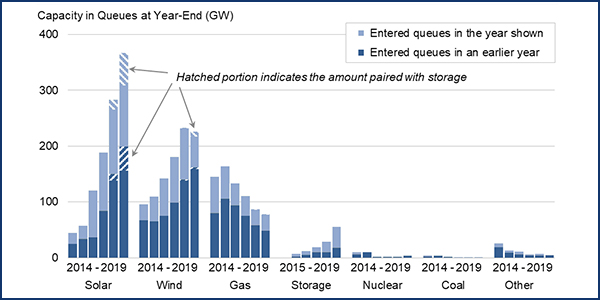FERC stopped short of ordering RTOs and ISOs to modify market rules to foster participation by hybrid resources, instead directing the grid operators to submit detailed reports about their existing efforts to accommodate the growing number of renewables paired with energy storage (AD20-9).
The directive, released Jan. 19, comes six months after FERC convened a technical conference to explore whether it should require rule changes to open organized electricity markets to hybrid resources in the same way Order 841 cut a path for storage-only resources. (See Hybrid Resource Developers Ask for Uniform Rules.)
Resource developers participating in the one-day conference had called on FERC to issue a rulemaking. They said existing RTO practices leave too much uncertainty for hybrids, ranging from interconnection agreements that hamper the ability to add storage to projects already in the queue to market participation models that fail to recognize the ways hybrid resources can be configured to provide multiple services to the market.
Rachel McMahon, senior manager of public policy at Sunrun, called at the conference for “clear and consistent workable rules.” McMahon said Sunrun did not have a “clear, easy or economically viable path to provide” capacity or energy services even in CAISO, which has the most advanced participation rules in the country.
Speaking at the same conference, CAISO Director of Infrastructure Contracts and Management Deborah Levine acknowledged that grid operators are facing a “tsunamic wave” of storage, but also cautioned that “we need to get some more operations under our belt before we start changing the rules.”
Request, Not Reforms
FERC’s order tilted in favor of the grid operators — at least for now. In it, the commission noted that most RTOs and ISOs emphasized in their post-conference comments that they are already working to address the needs of hybrid resources.
“Given these ongoing efforts, several RTOs/ISOs requested that the commission either allow such work to continue before taking additional action, or provide for flexibility in any such action,” FERC wrote. “In consideration of these comments, we are not directing specific reforms at this time.”
Rather than handing mandating rule changes, FERC asked the RTOs to submit reports describing present and pending practices for addressing four hybrid resource issues, including those related to terminology, interconnection processes, market participation and capacity valuation.
On terminology, the RTOs must explain whether their tariffs or business practice manuals contain a definition of a hybrid resource and, if not, how they categorize any existing hybrid resources in their interconnection queues.
“Similarly, if the RTO/ISO does not have a definition, but there are hybrid resources, as described above, participating in the RTO/ISO markets, the RTO/ISO should explain how they have been participating to date — for instance, as a generator or as part of an energy storage participation model” the commission wrote.
Regarding interconnections, each RTO must describe the process for both a hybrid resource newly entering the queue and a resource adding a storage component to an existing interconnection request.
“The description should include details of interconnection request requirements that are specific to hybrid resources (such as parameters necessary for transmission providers to adequately model hybrid resources), how the RTO/ISO models these types of resources both for reliability and market participation, and how an RTO/ISO would treat a request for the addition of storage to an existing interconnection request,” FERC said.
RTOs must also provide details about any potential changes to tariffs, business practice manuals or stakeholder processes that could affect interconnection of hybrid resources.
Regarding market participation, RTOs are asked to explain how hybrid resources are currently participating in energy, ancillary services and capacity markets, including a description of what services the resources are allowed to provide and how their participation is modeled.
“Where the RTO/ISO has modeling and bidding provisions unique to hybrid resources, it should enumerate such provisions,” the commission said. “If no specific provisions exist, the RTO/ISO should provide an explanation of whether and how hybrid resources have participated in its markets to date. If hybrid resources are not able to provide certain services, the RTO/ISO should provide an explanation of why they are not able to provide such services.”
Finally, RTOs must describe what methods they use to determine the capacity values of hybrid resources in their markets — or any changes being planned or under discussion in stakeholder processes.
“The RTOs/ISOs are at various stages of either considering or proposing changes to more distinctly accommodate the unique characteristics of hybrid resources,” FERC noted.
RTOs must submit their reports to FERC within 180 days.



